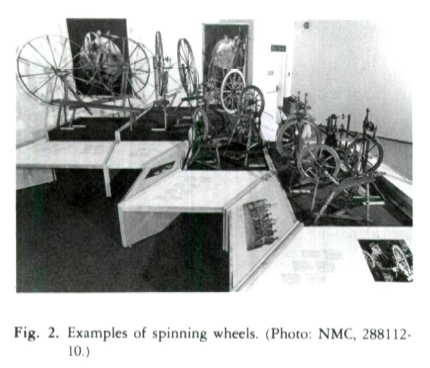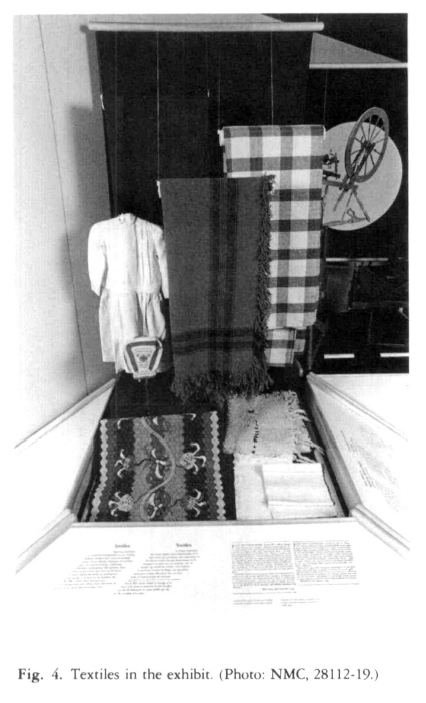Reviews / Comptes rendus
National Museum of Man, "The Ever-Whirling Wheel: Spinning Wheels in Canada"
1 Handspinning in Canada began before European colonization and has changed and evolved over the years. The National Museum of Man's recent exhibit of Canadian spinning wheels explores the great variety of wheels that were made and/or used in Canada. The exhibit is divided into three main islands: the other processes that are a part of making yarn, the various regional and ethnic characteristics of wheels, and the operation of wheels. Also included are a few examples of handspun textiles and modern spinning wheels.
2 The first island, "Spinning was only one of the steps," begins by showing the equipment required to prepare fibre for spinning and to ply and wind yarn in preparation for the next step in the production of clothing or other textile items. An example of each tool is given with a description of how the tool is used. All the artifacts in the exhibit are on raised platforms covered with deep red fabric. In front of these platforms are panels of text with line drawings of a figure using each object. As there are no exhibit cases, the panels are effective as security barriers between the viewer and the artifacts. Behind each of the islands are hanging banners which display photographs printed on fabric and show the equipment in use. They are useful in drawing the artifacts and text together, although they would have been more effective had the contrast of colours (deep red and beige) been stronger and the images clearer. The section concludes with the use of a drop spindle. Text and visuals, including a ghostly model of the face and hands of a spinster who looks like the pre-Raphaelite painting of Ophelia, are used to explain the principle of a drop spindle. Some fascinating Salish whorls are exhibited.
 Display large image of Figure 1
Display large image of Figure 13 A technical problem, which is evident throughout the exhibit, appears in the first island: the text describing a given artifact is not always directly in front of the artifact making it somewhat difficult to follow the story-line. Fortunately the items themselves are labelled so they can be matched to the description. One label lacks its corresponding wheel, the result of a last-minute decision to remove a half-dozen spinning wheels from the exhibit because of lack of space.
4 The second, and most successful island, "Spinning wheels in Canada," concentrates upon the wheels and their regional and ethnic variations. Seeing all of these wheels gathered together and the variety of shapes, sizes, materials, colours, and sophistication is very impressive. Their selection and display are both excellent. Although the text for the first island concentrates upon the use of the artifact and reveals nothing about the artifact itself other than its name, here the wheels are described in detail:
5 This is much greater detail than most people are prepared to read but does mention a number of interesting points: that Salish people spun before European contact, that their spindles could produce thick yarns, that European wheels were adapted following the Salish model and that some modern wheels utilize the same principle.
6 There is a similar discussion of the Quebec Flyer Wheel, "a Canadian phenomenon," which had been developed to produce
7 Each wheel is seen as a unique object and also as a part of the evolution of a variety of wheels. Some are hand-crafted, some manufactured. All are a reflection of the ingenuity of those who produced them.
8 The third island begins with a section titled "Textiles," which is intended to show that "Spinning represents an initial but fundamental step in creating clothing, blankets and various household needs." The textiles selected show a variety of other possible steps: weaving, crocheting, knitting, and sewing. However, they are not particularly attractive or interesting examples and are unimaginatively displayed.
9 Also in this section is an advertisement from a Montreal newspaper of 1793. It is included as an "example of the variety of ready-made clothing and textiles available in 18th Century Canada," yet it is not a good example. The year 1793 is rather late in the century, Montreal cannot be conceived of as Canada, and the only article of clothing mentioned is gloves. Presumably the advertisement is included to support the statement in the introduction that "at no period in Canadian History did everyone spin, nor was home-spinning and weaving ever the only method of acquiring such basic necessities as clothing and other coverings. The pioneer myth of a wheel at every hearth has been exaggerated." This is true but the exhibit does not support the statement. In fact, with the variety of wheels shown and used across the country by so many different ethnic groups, and the photographs of numerous people spinning, the opposite impression is given.
10 The other part of the third island, "How does a spinning wheel work?" gives a fairly technical explanation and displays wheels according to their physical principles rather than regional characteristics. This is probably too technical for most viewers, but it does explain some terms like spindle flyer and treadle which the previous islands use. It might have been better to explain the principle of spinning before showing the variations of wheels.
11 The exhibit concludes with a simplistic video show of people spinning wool and flax, using walking and treadle wheels. There were also very popular and effective demonstrations twice a week by three area weavers' and spinners' guilds using the modern wheels in the exhibit. An Oracle pamphlet available at the museum is interesting for children; it is unfortunate that the Mercury publication Selected Canadian Spinning Wheels in Perspective was unavailable. It explains in great detail the wheels, processes and principles discussed in the exhibit and was written by the guest curator of the exhibit, Judith Buxton-Keenlyside.
 Display large image of Figure 3
Display large image of Figure 312 Overall, it was a very interesting exhibit and a real treat to see so many wheels gathered together. Although spinning wheels are often included in museum exhibits, they are usually shown in their context and rarely seen in an environment like this one where the viewer can compare various types of wheels and consider the adaptations made by different ethnic groups across the country. Most of the emphasis in textile production exhibits usually centres on weaving or textiles, making the focus on wheels all the more significant.

